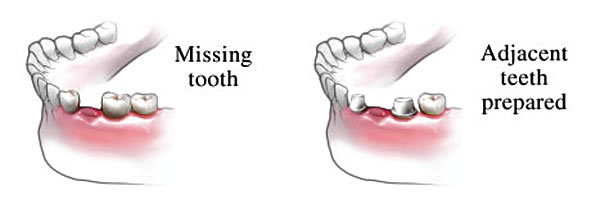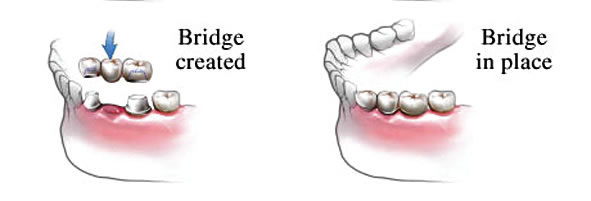WHAT IS A DENTAL BRIDGE?
A dental bridge is two or more dental crowns that are joined together to form one unit. They therefore “bridge” over a gap or space, left by another tooth that was removed. Dental bridges are non-removable and feel and look just like real teeth (also called fixed dental bridges).
The downside of a dental bridge is that it relies on your existing anchor teeth to support it. If these anchor teeth are well looked after, you can expect a good quality restoration for many years to come.
DENTAL BRIDGE PROCEDURE
First Appointment
After numbing the area, the anchor teeth get prepared by doing a 360 º preparation to ensure enough space for the fabrication of the retainer crowns. All insertion lines must be parallel to facilitate insertion.
Impressions are taken to be send away to a dental laboratory. These impressions will be used to make plaster models in order to fabricate the dental bridge.
A temporary bridge / restoration is fitted to protect the naked anchor teeth until the next visit.
Second Appointment
The temporary bridge / restoration is taken off and the new dental bridge is fitted.
  |
DENTAL BRIDGE VS DENTAL IMPLANT
There are some differences between Dental Bridges and Dental Implants.
The main difference between these two options, is what keeps it staying in the patient’s mouth. Dental Bridges rely on existing healthy anchor teeth, where Dental Implants need enough bone to stabilise it in the jaw. Dental Implants are more long-term than Dental Bridges, because of Dental Implant’s resistance to tooth decay (metal structure). Dental Implants are therefore also more expensive and more time is needed from the first to the final visit.
DENTAL BRIDGE CARE
Cleaning dental bridges is very important. Since decay under the dental bridge is still a possibility, general cleaning and hygienic procedures are advised:
• Daily brushing and rinsing with a mouth rinse.
• Special soft pics to aid in the cleaning process.
• Flossing with special floss (Superfloss®) is important to get underneath the pontic tooth.
• Avoid chewing on hard objects and ice needed from the first to the final visit.
